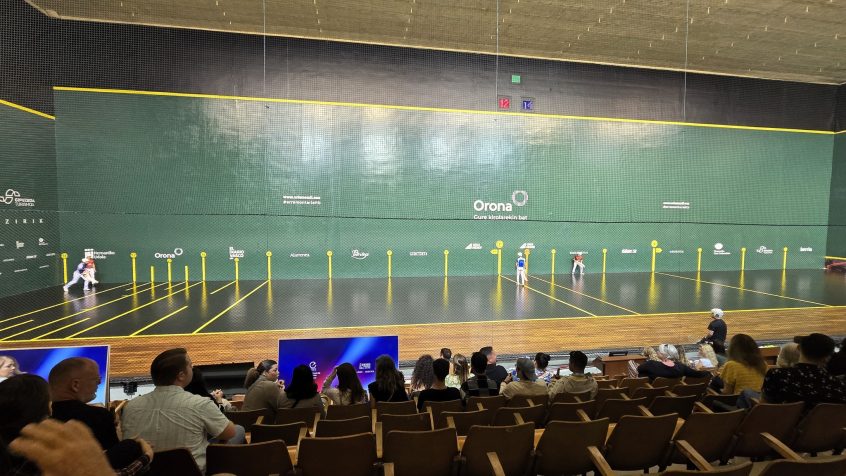After the tour was over yesterday I had just enough time to return to the apartment, relax for a few minutes and then head out to the first “official” event of the conference. We took buses to a town just outside of San Sebastian to attend a Jai Alai match. For those of you who don’t know what Jai Alai is, it’s a fast-paced sport that originated here in the Basque region of Spain.
It was a chance for us to experience an extremely popular local activity. When we arrived, there was unlimited beer, olives, and cheese. I grabbed a bottle of water (my drink of choice) and a seat with a great view of the “fronton,” the court. The fronton is long (about 180 feet) with three walls, side, back and front and netting separating the audience from the court. Jai alai is in some ways similar to racquetball or handball, but the equipment—a curved handheld wicker scoop used to catch and throw the ball—is quite different.
When I was a kid three Jai Alai frontons opened in Connecticut. My father had been an accomplished handball player when he grew up in Brooklyn. So, of course, he wanted to see a match. I remember it surprisingly clearly. While I didn’t recall the rules, it looked familiar and was a lot of fun to watch.
From there, we boarded buses and headed to the Petritegi Cider House. Alcoholic cider is a big deal in Basque Spain. They grow more than one hundred “official” varieties of apples. On arriving, two men were pounding out rhythms on boards. A few days before I’d heard the story of this rhythmic pounding. “You can stomp on grapes with your feet,” the guide said, “but it’s tough to do that with apples.” Instead, young men were hired to bash the apples with poles until the juice was separated from the pulp. That was a boring job, so they began to bash the poles to create tunes. I’d never seen anything quite like it. Not exactly the best music I’ve ever heard, but mesmerizing—I simply couldn’t walk off.
Dinner was calling, so I eventually made my way inside the restaurant. It’s an enormous space (it easily held all 350 conference participants). At communal tables we were served platters of traditional foods—salt cod omelet, fried cod with peppers, an enormous T-bone steak, and for dessert, local cheese, quince jelly, walnuts in the shell and cookies.
To get the cider, everyone goes to the cider cellar with a couple dozen ginormous barrels. The “cellar man” turns a spigot and out comes the cider which you catch with your glass. You can go back as often as you like, sampling a variety of different ciders.
By the end of the meal, I’d eaten and drunk way too much.

